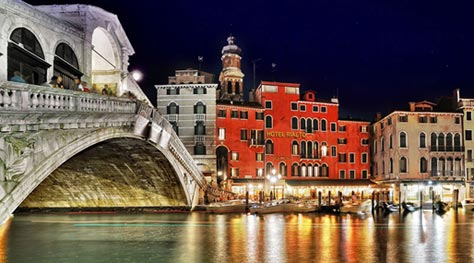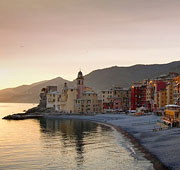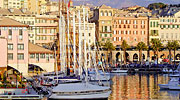The Art of Mourning
Many Italian cemetaries are poignant outdoor museums of art and architecture
Monumental graveyards have dotted the Italian countryside since the time of the Etruscan civilization, during which entire cities devoted to the dead were constructed long before the Ancient Romans conquered the peninsula.
In the 19th century, Napoleon decreed with the Edict of Saint Cloud that the dead could no longer be laid to rest in churches or town centers, leading to a wave of sprawling new cemeteries constructed on the outskirts of Italy's major cities, in which some of the country's finest funerary art was placed.
Genoa, Cimiterio Monumentale di Staglieno
Some of the most moving examples of funerary art in the 19th century are in Genoa's Cimitero Monumentale, an immense cemetary covering an entire square kilometer of the Staglieno hillside. The grounds are thick with poignant works of sculpture by notable artists created on commission for a number of Genoa's most wealthy families, who wanted to build impressive final resting places.
It's impossible not to be moved by the sad beauty of statues by gifted sculptors like Leonardo Bistolfi, Augusto Rivalta, Giulio Monteverde, and Edoardo Alfieri; their ability to creat the illusion of soft flesh and convey emotion in marble is truly remarkable.
It is striking and poignant the number of newly-weds, young mothers, and children to whom statues and markers are dedicated, but remember that the 19th century was a time when the number of people who died long before or shortly after reaching adulthood was significantly higher than it is today. Youth and beauty were not enough to ensure survival before antibiotics and the advent of modern medicine.
This is surely one of the reasons why the sculptures are so emotionally powerful, as they rail against the cruelest of destinies and the most devastating of losses. They grieve for the particularly painful premature end of a life and, in many cases, of a love, which had only just begun.
Milan, Cimitero Monumentale
Carlo Maciachini's Monumental Cemetery, inaugurated in 1866, was designed to replace a number of smaller cemeteries in the city center with one large burial ground on the outskirts of Milan.
Milan's Monumental Cemetery has impressive display of classical and contemporary funereal art, reflecting the wealth and prosperity of Italy's fashion and finance capital. Among the works there are small replicas of Greek temples, Egyptian obelisks, Ancient Roman artwork, and modern sculpture by artists including Giò Ponti, Arturo Martini, Lucio Fontana and Giò Pomodoro.
Venice, Cimitero di San Michele
Death in Venice is one thing, burial in Venice is another.
For centuries, Venetians buried their dead beneath the paving stones in the center of this lagoon city, a decidedly insanitary practice which most probably shortened the life expectancy of those citizens still living.
It was during the Austrian occupation in the 19th century, authorities decided it was time to build a "proper" cemetery and end this local funerary rite. Thus, the small island of San Michele was transformed into a graveyard and special funeral gondolas were used to sail bodies to their final resting place.
Almost two centuries later, the island is home to hundreds of tombs of Venetians and lovers of Venice, including those of Igor Stravinsky and Ezra Pound. Indeed, the cemetary has become so crowded that today the dead are only guaranteed a 15 year stay, after which their remains are cremated or transferred elsewhere.
Rome, Cimitero Acattolico di Testaccio
It might make one in love with death, to think that one should be buried in so sweet a place
Shelley wrote this ode to the Non-Catholic Cemetery of Testaccio in Rome...ironically, shortly before he drowned off the Tuscan coast and was subsequently buried in the graveyard which he had so admired.
Rome's Non-Catholic Cemetery in Testaccio, located close to the Pyramid of Cestius and the ancient Aurelian wall, is one of the best known and most visited graveyards in Italy.
Final resting place of Shelley, Keats, Antonio Gramsci and many other famous Italian and foreign poets, painters, and politicians, the cemetery contains grave markers and tombs inscribed in English, Russian, Greek, Japanese and 15 other languages.
The cemetary is home to a number of beautiful statues, but perhaps the most poignant is the fallen angel grieving over Emelyn Story's grave.
Capri, Cimitero Acattolico
Whereas the other monumental cemetaries mentioned here have magnificent works of art, the Non-Catholic Cemetary of Capri instead boasts a magnificent view. Relatively small, this burial ground is home to only 204 tombs of artists and intellectuals from England, Germany, Russia, and America who have lived and died on Capri over the past century.
During a stroll through, visitors can read inscriptions dedicated to Lucio Amelio, the baron Fersen, Norman Douglas, and Grace Fields...but also a number of unknown names, most young men and women who suffered from tuberculosis and had travelled to Capri from across Europe seeking relief in the Mediterranean climate. A sort of Mediterranean Spoon River, telling a little known history of this island.
Our Insider is
Could you be our next Insider? Share your love of Italy by contributing to ItalyTraveller! See how!
























